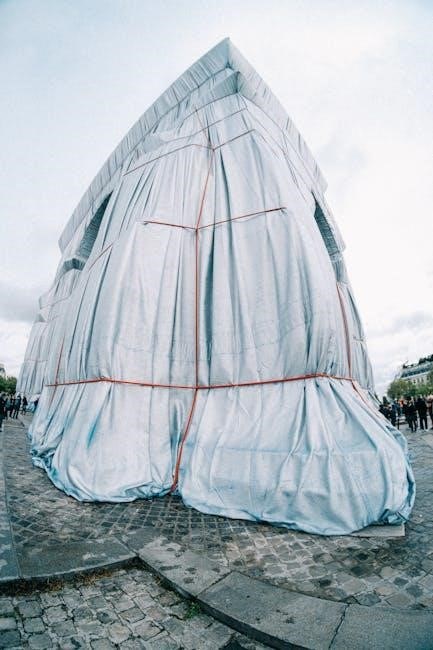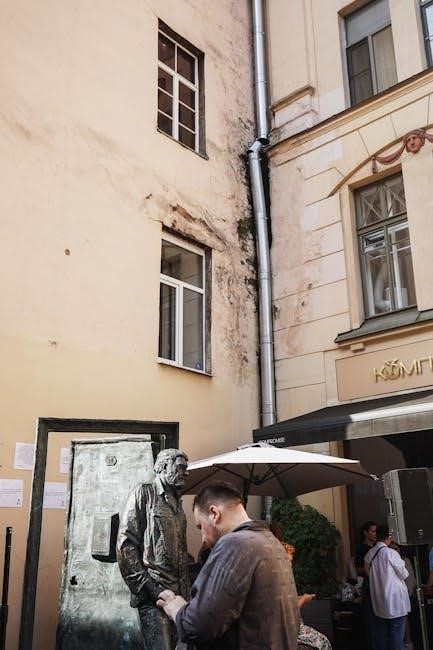A central heating pump is a vital component in modern heating systems, circulating hot water from the boiler to radiators and back. Its efficient operation ensures consistent heat distribution, making it indispensable for maintaining a comfortable home environment. Proper installation and maintenance are crucial for optimal performance and energy efficiency.
1.1 What is a Central Heating Pump?
A central heating pump is a device that circulates hot water from the boiler through the radiators and back, ensuring efficient heat distribution. It operates quietly, typically located near the boiler, and is essential for maintaining consistent warmth in a home. Modern pumps are energy-efficient, suitable for both constant and variable flow systems, and play a crucial role in optimizing heating performance and reducing energy consumption.
1;2 Importance of a Central Heating Pump in a Heating System
A central heating pump is crucial for ensuring efficient heat distribution, circulating hot water from the boiler to radiators and back. It prevents overheating, maintains consistent warmth, and supports energy efficiency. A reliable pump minimizes heat loss, reduces energy bills, and ensures the system operates smoothly, making it an essential component for optimal heating performance and comfort in any home.
Pre-Installation Requirements
Ensure compatibility with your heating system, gather tools and materials, and protect the area from water leaks. Proper preparation ensures a smooth installation process.
2.1 Checking Compatibility with Your Heating System
Before installing a central heating pump, verify its compatibility with your boiler, radiators, and existing pipes. Check the pump’s flow rate and pressure specifications to match your system’s requirements. Compatibility ensures efficient operation and prevents potential system damage or reduced performance. Refer to manufacturer guidelines for detailed specifications and recommendations.
2.2 Gathering Necessary Tools and Materials
To ensure a smooth installation, gather essential tools and materials. These include adjustable wrenches, pipe cutters, isolation valves, and connectors. Additionally, have a bucket, towels, and a drain key ready for draining the system. Proper preparation minimizes delays and potential mess during the installation process. Always refer to the manufacturer’s list for specific requirements tailored to your pump and system.

Step-by-Step Installation Process
Installing a central heating pump involves systematic steps, from disconnecting power and water to fitting the new pump. Each phase ensures safe and efficient replacement.
3.1 Shutting Off Electricity and Water Supply
Shutting off electricity and water supply is the first and most crucial step in installing a central heating pump. Locate the main electrical switch and turn it off to ensure safety. Next, identify the isolation valves on both sides of the pump and close them to prevent water flow. This step prevents electrical hazards and water damage, ensuring a safe working environment.
3.2 Draining the System and Isolating the Pump
After shutting off the electricity and water supply, drain the heating system to prevent water spillage. Connect a drain hose to the system’s drain valve and direct it to a suitable location. Open the valve slowly to allow the water to flow out. Once drained, isolate the pump by disconnecting its electrical connectors and securing it to prevent accidental activation during installation.
3.3 Removing the Old Pump and Installing the New One
Disconnect the old pump’s electrical and water connections carefully. Remove any mounting brackets or screws securing it. Gently lift the old pump out and set it aside. Place the new pump in the same location, ensuring proper alignment with the system. Reattach using the provided hardware, tightening securely. Double-check all connections for leaks before proceeding to the next step.
3.4 Reconnecting Water Valves and Electrical Connections
Reconnect the water valves, ensuring they are fully open to allow proper flow. Next, reconnect the electrical connections, referencing the manufacturer’s wiring diagram. Secure all terminals tightly to prevent loose connections. Turn the power supply back on and slowly open the water supply valves to avoid sudden pressure spikes. Check for leaks at all connections before proceeding to test the system.

Post-Installation Checks
After installation, test the pump for proper functionality, bleed the system to remove air locks, and ensure all connections are secure to prevent leaks and ensure smooth operation.
4.1 Testing the Pump for Proper Functionality
After installation, turn on the pump and monitor its operation. Check for smooth flow, consistent pressure, and quiet running. Ensure there are no leaks and that the pump effectively circulates water through the system. Verify that the pump operates within the recommended speed and pressure settings specified by the manufacturer for optimal performance and longevity.
4.2 Bleeding the System to Remove Air Locks
Bleeding the system is essential to remove air locks that can hinder proper water circulation. Turn on the heating and check radiators for cold spots. Use a radiator key to release air, starting from the lowest points. Repeat until water flows freely, ensuring the system operates efficiently without noise or reduced performance caused by trapped air.
Maintenance and Troubleshooting
Regular maintenance ensures the pump operates efficiently, while troubleshooting addresses common issues like noise or reduced flow. Proper care extends lifespan and maintains system performance effectively.
5.1 Regular Maintenance Tips for the Pump
Regular maintenance involves checking for leaks, ensuring proper electrical connections, and cleaning the pump. Lubricating moving parts and inspecting impellers for wear can prevent failures. Monitoring noise levels and flow rates helps identify issues early. Annual professional servicing is recommended to maintain efficiency and extend the pump’s lifespan, ensuring optimal system performance and reliability year-round.
5.2 Common Issues and How to Fix Them
Common issues include air locks, faulty electrical connections, and worn-out seals. Air locks can cause poor circulation; bleeding the system resolves this. Electrical faults may require professional repair. Worn seals or impellers should be replaced promptly to prevent leaks and inefficiency. Regular checks and addressing issues early can prevent system failures and ensure smooth operation, saving time and money in the long run.

Costs and Benefits of Installing a New Pump
Installing a new pump typically costs £200-£500, with professional installation adding £100-£300. Benefits include improved energy efficiency, lower bills, and reduced carbon emissions, while modern pumps last 10-15 years.
6.1 Estimated Costs of Installation
The cost of installing a new central heating pump typically ranges from £200 to £500, depending on the pump’s quality and brand. Labour costs for professional installation can add an additional £100 to £300. While DIY installation may save money, hiring a qualified technician ensures proper setup, optimal performance, and warranty validation. Always compare quotes to find the best value for your budget.
6.2 Energy Efficiency and Long-Term Savings
Modern central heating pumps are designed to enhance energy efficiency, reducing energy consumption and lowering utility bills. By optimizing water circulation, they minimize heat loss and ensure consistent warmth. Over time, these improvements lead to significant cost savings. Additionally, eco-friendly models reduce carbon emissions, making them a sustainable choice. Proper installation and maintenance further maximize efficiency, ensuring long-term financial and environmental benefits for homeowners.
Safety Considerations
Always handle electrical components with care, ensuring power is off before starting work. Prevent water damage by properly sealing connections and using protective equipment when necessary.
7.1 Handling Electrical Components Safely
When handling electrical components during pump installation, always switch off the power supply at the mains. Verify the circuit is dead using a voltage tester before starting work. Avoid touching live wires and ensure all connections are secure. Wear insulated gloves and use appropriate tools to prevent shocks or electrical hazards. Safety should never be compromised.
7.2 Preventing Water Damage During Installation
To prevent water damage, always turn off the main water supply before starting work. Use a bucket to catch any residual water when disconnecting pipes. Ensure all valves are securely closed and inspect for leaks. Keep towels or absorbent materials nearby to mop up spills. Properly isolate the system to avoid unexpected water flow, and consider using a drain hose to direct excess water safely away.
Environmental Impact
Modern central heating pumps are designed to reduce energy consumption, lowering carbon emissions and promoting eco-friendly heating solutions. Energy efficiency directly contributes to a smaller environmental footprint.
8.1 Energy Efficiency of Modern Pumps
Modern central heating pumps are engineered with advanced technology to maximize energy efficiency, reducing overall energy consumption. These pumps often feature variable speed motors and smart controls, which optimize water circulation based on system demand. By minimizing unnecessary energy use, they contribute to lower carbon emissions and long-term cost savings for homeowners. This makes them an eco-friendly choice for heating systems.
8.2 Eco-Friendly Installation Practices
Eco-friendly installation practices involve using sustainable materials, minimizing waste, and ensuring proper system sealing to prevent leaks. Techniques like efficient wiring and smart thermostat integration optimize energy use. Recycling old pumps and responsibly disposing of packaging further reduce environmental impact. These practices not only benefit the planet but also enhance the system’s long-term efficiency and performance.
Proper installation and maintenance of a central heating pump ensure efficient performance, energy savings, and reliable warmth. Follow guidelines for optimal results and long-term comfort.
9.1 Summary of Key Installation Steps
- Shut off electricity and water supply to ensure safety.
- Drain the system and isolate the old pump.
- Remove the old pump and install the new one.
- Reconnect water valves and electrical connections.
- Test the pump for proper functionality.
- Bleed the system to remove air locks.
Following these steps ensures a smooth and efficient installation process.
9.2 Final Tips for Optimal Performance
To ensure your central heating pump operates efficiently, schedule regular maintenance, monitor performance, and address issues promptly. Keep the system balanced, inspect electrical connections, and maintain proper water pressure. Clean filters and ensure the pump is free from debris. Consider upgrading to smart controls for enhanced energy management. Annual servicing by a professional can prevent premature wear and extend the pump’s lifespan.

Additional Resources
Explore recommended tools, suppliers, and expert guides for central heating pump installation. Visit manufacturer websites like Grundfos for detailed instructions and troubleshooting tips to ensure success.
10.1 Recommended Tools and Suppliers
For a successful installation, use tools like pipe cutters, adjustable spanners, and drain hoses. Trusted suppliers include Grundfos, Wilo, and Worcester Bosch, offering high-quality pumps. Ensure compatibility with your system for optimal performance. These suppliers provide reliable products and expert support, making them top choices for central heating pump installations.
10.2 Further Reading and Expert Guides
For deeper insights, explore guides from trusted sources like Grundfos and Worcester Bosch. Expert tutorials on YouTube and HVAC forums offer practical advice. Step-by-step installation manuals and troubleshooting tips are available on manufacturer websites. Additionally, energy efficiency guides from government websites provide valuable information on optimizing your heating system. These resources ensure a well-rounded understanding of central heating pump installation and maintenance.

Be First to Comment